







IPCS |
International Programme on Chemical Safety |
 Safety and Health in the Use of Chemicals at Work
Safety and Health in the Use of Chemicals at Work
A training manual
Abu Bakar Che Man and David Gold
An ILO contribution to
the International Programme on Chemical Safety
(a collaborative programme of the United Nations Environment Programme, the International
Labour Organization and the World Health Organization)
6. Management of a chemical control programme
The ultimate responsibility to use chemicals safely in an enterprise rests with management. Management has the authority and the resources to develop and carry out programmes spelling out methods and procedures on safety and health in the use of chemicals at work (figure 51). To be effective, the programme-for managing the safe use of chemicals should receive a priority similar to other programmes within the enterprise such as production, marketing, maintenance and quality control. The measure of success will materialize in the form of a better working environment, a reduction in workplace accidents and diseases, a healthier workforce and a reduction in waste. Together,. these elements will lead to increased productivity and profits for the enterprise.
This chapter describes the steps to be taken in managing a chemical control programme.
| Remember: There are three ideas underlying a programme for the safe management of chemicals: 1. Management should know all the chemicals being used in the enterprise, including their quantities and their associated hazards. 2. Workers should know the hazards associated with the chemicals they work with and should be trained in the necessary precautions. 3. Workplaces should be designed or adapted to the needs of the worker instead of attempting to adopt the worker to the workplace. |
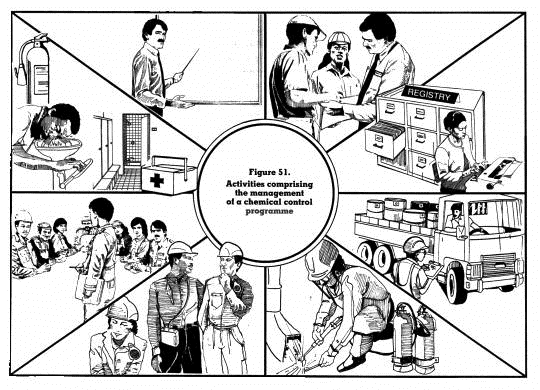
In order to control any programme activity successfully, a clear policy for the safe use of chemicals is required. This is a broad statement of goals by top management which is made known to managers, workers and others who deal with the enterprise so that the way they do their jobs and carry out decisions is guided by the policy. This general principle can be incorporated into a policy statement for a comprehensive control programme.
A policy statement on the management of chemicals might include the following commitment:
To complement the policy statement, the enterprise should list its main priorities that would enable it to set goals. For example, before a hazardous chemical is used, the enterprise may require a full investigation into the degree of risks it poses, taking into account the economic and operational impact of substitution. Another priority may require that exposure levels of a hazardous chemical should be at the lowest practicable level if it is found that the use of such a chemical is essential for the process. Since these listed priorities provide the means to set goals, they should be as wide-ranging as possible.
Discussion questions:
| Remember: Every enterprise should have a clear policy on the safe management of chemicals. |
6.2. 1. Cooperation at the workplace
To coordinate and plan activities on safety and health in the use of chemicals, it is important to identify a group of people who take the initiative of establishing a plan and monitoring its implementation. Depending on the size of the enterprise, the size of the group could range from two people (a representative of management and a workers' representative) to a working team. Ideally, the group should consist of a representative from management with authority, a safety officer and an industrial hygienist (to provide the professional backing), as well as representatives from among the workers using, chemicals and having responsibility for storage.
For small organizations which lack professional support, outside assistance may be sought, especially during the initial stages. This assistance might come from a consultant, local trade associations or a government agency. It is essential that the group receives the full support of management. The group's activities should be closely guided by the strategies as reflected in the enterprise's policy.
Employers and workers have certain roles and responsibilities which should be reflected in the chemical safety programme.
| Role
of employers Employers should: - ensure that chemicals are stored
safely, and that unauthorized access is prevented; (a) as far as possible, choosing
chemicals that eliminate or minimize the risk; Employers, in carrying out their duties, should cooperate with workers and their representatives with regard to safety and h health ' the use of chemicals at work. |
Role
of workers Workers should cooperate with employers in carrying out their duties and should comply with all procedures and practices relating to safety and health in the use of chemicals at work. They should note and follow the instructions given by the manufacturer, supplier, employer or supervisor. Workers should take all reasonable steps to minimize risk to themselves or others, property or the environment. In addition, they should: - use properly all devices provided
for their protection or the protection of others; Workers should also have the right to: - draw the attention of their
representatives or the employer to potential hazards arising from the use of chemicals at
work; |
Discussion questions:
The first task of the group responsible for the coordination and planning of safety in the use of chemicals is to make a master inventory of the chemicals in use. The inventory should include every chemical used, its physical state and the estimated quantity used per month. This inventory process can only be accomplished by inspecting every work section, raw materials depot and storage area. Methods used for the transport, handling, storage and disposal of chemicals should also be noted.
The purpose of establishing the inventory is to develop basic safety information for the safe use of all chemicals in the enterprise. Chemical safety data sheets will provide most of the necessary data. (If these are not immediately available, the supplier of the chemical should be contacted and requested to provide the information.) From this information ion, the committee should analyse the use of hazardous chemicals and consider substituting less hazardous ones. If substitution is not technically and economically feasible, other preventive measures should be exploited such as installing engineering controls and implementing safe procedures and practices in the use of chemicals.
Safety and health data should also be made known to all workers who come into contact with the chemicals through a training programme and a manual on safe work procedures and practices.
| Remember: Chemical safety data sheets will provide the basic safety information for chemicals in the workplace. |
Discussion questions:
The second task of the group is to become involved in establishing and monitoring a purchasing procedure based on the rationale that all chemicals which enter the workplace should be endorsed by the group, properly identified, classified and labeled. Through this procedure, the group could examine and monitor whether the purchase of new chemicals would be suitable for use. The procedure should also call for the enterprise to consult the relevant national authority on regulations to determine labeling requirements and include these requirements in the purchase specifications.
Finally, the procedure should include a regular review of chemicals currently in use to evaluate whether or not their use should be continued.
Discussion question:
Describe the purchasing procedure in your plant which ensures that all chemicals are properly identified, classified and labeled.
6.2.4. Receipt, identification, classification and labeling
The third task of the group is to collaborate with the purchasing department in taking the necessary steps when a chemical first enters the workplace. It must be ensured that each chemical is correctly identified, classified and labeled, with an up-to-date chemical safety data sheet on hand. These conditions should always be met before the chemical is placed in storage or put into use. This task can be facilitated if the enterprise's purchasing department spells out the requirements in the purchasing specifications.
Every container holding a chemical should be clearly marked with a label. The purpose of the label is to provide everyone who comes into contact with, or is working in close proximity to, the chemical with essential information regarding its identity, classification, the hazards it presents and the safety precautions to be observed. Supervisors and workers should cooperate with management to make sure that each chemical container and package has a properly prepared label.
Section 4.2.2 gives a complete list of information that should be included on the label.
Discussion:
Describe a method whereby all containers in the workplace holding chemicals can be clearly marked with the necessary information.
| Remember: Every container for chemicals should carry an appropriate label. Unlabelled containers should not be used |
6.2.5. Day-to-day management of chemicals: Control measures
There are certain concrete activities that management should undertake to ensure safety and health in the use of chemicals at the workplace. These should apply to all workstations within the enterprise:
Management should address the daily issues pertaining to the use of chemicals with a view to protecting workers from the risks arising from day-to-day work. Exposure can be eliminated or reduced by establishing safe procedures and practices, as already explained in this manual. The best method would be to replace hazardous chemicals with less hazardous ones. If this is not possible, the processes using the chemicals should be enclosed, or local ventilation systems installed and maintained regularly. Personal protective equipment should only be provided as a supplement to other operational control measures.
The remainder of this chapter will discuss in detail the control measures listed above.
| Remember: Ensure that all chemicals are in appropriate containers with proper labels and chemical safety data sheets |
Many systems are available for the classification and labeling of chemicals. Classification varies from one country to another. The responsibility for the correct classification and labeling rests with the supplier.
In the working environment, chemicals are classified according to their potential hazards to workers. The criteria for classification should be based upon the chemical's inherent health and physical hazards and should include the following:
For example, a chemical can be classified as explosive, oxidizing, flammable, toxic, corrosive, irritating or harmful, along with appropriate danger symbols (See an example from the EC). The national authority should be consulted on the classification criteria for different types of chemicals.
The need for labeling of every chemical in the workplace and for chemical safety data sheets has already been mentioned in this manual.
At the enterprise, unlabelled chemicals that enter the workplace should not be handled until the supplier provides adequate information. Chemicals that have been dispensed into other containers should always be adequately relabeled. Many accidents have happened because chemical containers were not relabeled.
Discussion questions:
| Remember: Provide information and instruction to all workers concerning safe use and storage. |
Management has the responsibility to ensure that:
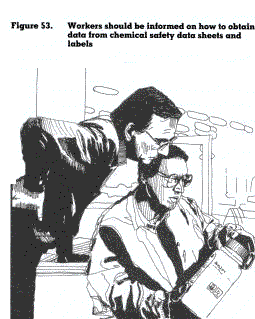
As arrangements for emergencies frequently involve workers, management has the responsibility to inform workers clearly of their role and to train them in the exact measures carried out during an emergency.
Proper storage is another important element in a programme for the safe management of chemicals. Management should consider factors such as:
Different classes of chemicals require different types of storage. For example, flammable chemicals should not be stored in the proximity of oxidizing materials and the storage area should be cool, away from sources of ignition and well ventilated. Chemicals which react with water (lithium, sodium, potassium, calcium) should be stored in a dry, cool and well-ventilated area. Sprinkler systems should not be installed in this area.
Discussion questions:
| Remember: Ensure cooperation for improved control. |
An integral part of the management of safety and health in the use of chemicals is cooperation between employers and workers. It is essential that management should foster a spirit of cooperation, allowing for close collaboration in the application of measures to promote the safe use of chemicals at the workplace (figure 54).
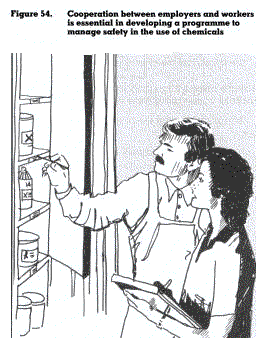
Cooperation also means that safety rules and procedures should be followed and any dangerous situation arising from faulty or inoperative control or protective devices should be reported immediately to management. As a general rule, workers should carry out their tasks safely and in a manner which will not pose any danger to other workers.
If requested by the worker, management should be able to provide information on the health hazards of chemicals or other information such as exposure monitoring data or medical examination data for a particular worker.
| Remember: Cooperation is an essential element of a successful occupational safety and health programme. |
During an inspection or investigation, the workers' representative should be allowed to participate if a request has been made to the management. Such cooperation will ensure the effectiveness and success of the chemical control programme.
Discussion questions:
| Remember: Manage the provision, use and maintenance of personal protective equipment |
Where risks cannot be eliminated or hazardous processes made safe, it is up to management to provide and maintain the appropriate personal protective equipment, including clothing, at no cost to the worker. Management should also implement measures to ensure the appropriate use of this equipment.
Chemical safety data sheets are the key source of information to management and workers concerning the selection of appropriate personal protective equipment for the risks that a chemical may present. Based on this and other information from individuals such as industrial hygienists and chemists, or from laboratories or the competent national authority, a programme should be developed (figure 55). This should include:
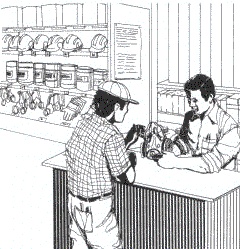
| Figure 55: Management should develop and implement a programme for the provision and maintenance of personal protective equipment when other controls are insufficient. |
Discussion questions:
1. Is personal protective equipment, appropriate to the hazard, provided at no cost to each worker exposed to dangerous chemicals?
2. How can workers be encouraged to properly select, use and maintain personal protective equipment?
| Remember: Develop, periodically evaluate and carry out drills in emergency |
Emergencies with chemicals can have catastrophic effects not only for workers but also for the community at large and the environment. Pre-emergency planning not only gives clear guidance to everyone in the enterprise as to what and what not to do, but it also provides an excellent opportunity for discussion with fire, police, medical and other emergency services outside the plant.
Management should establish emergency measures and facilities to deal with any eventuality. For example, in case of an accidental splash or contact with chemicals, emergency showers and eye-wash points should be provided in close proximity to the workstation (figure 56). These facilities should be regularly inspected to ensure that they are in operation when needed.
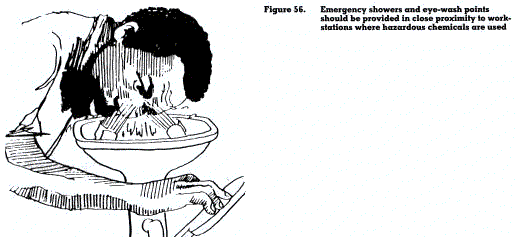
Similarly, in case of fire, suitable fire-fighting equipment should be provided to control the fire before fire-fighting units arrive. Workers who are involved in fire-fighting activities should receive adequate training. A fire evacuation plan should be established and rehearsed regularly to ensure smooth and speedy evacuation.
Management should also ensure that for every shift there are workers trained to administer first aid. They should check with the national legislation on the minimum number of first-aiders required for each shift. It should be noted that first aid can save lives or reduce the degree of injury if administered promptly.
Management has a responsibility to establish procedures to deal with emergencies and accidents that might arise from the use of hazardous chemicals at work. These procedures must be reviewed regularly and changed as appropriate when, for example:
As already mentioned, there is also a need for management to establish a training programme for workers to deal with chemical emergencies.
A training programme may include the following:
Discussion questions:
| Remember: Establish and maintain exposure monitoring procedures, including medical surveillance |
Management should establish a regular procedure to monitor the exposure levels of workers handling hazardous chemicals (figure 57). These levels should not exceed the acceptable limits promulgated by the national legislation. If exposure exceeds these limits, then immediate investigation should be conducted to determine the causes. Remedial actions should be taken promptly. During the period when corrective measures are being carried out, the workers must be provided with proper protective equipment or prevented from entering the contaminated area.
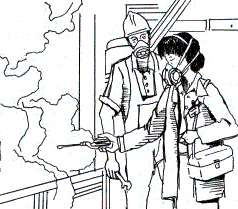
![]()
All exposure monitoring records should be kept and maintained in good order.
Workers exposed to chemicals should undergo medical surveillance, including periodic examinations, to monitor their health and determine whether working with chemicals has induced any adverse effects. Since most occupational diseases have a long latency period, surveillance provides an opportunity to detect these diseases at an early stage so that protective measures and appropriate treatment may be instituted. It is important to ensure that medical practitioners who administer these prograrnmes have adequate training in occupational medicine.
All health records should be maintained good order.
Discussion questions:
| Remember: Plan and implement training programmes |
Training and education form an important element in the management of hazardous chemicals. The installation of safety devices or procedures and practices to control chemicals should be complemented with training and education if implementation of the chemical control programme is to be effective.
All those who work with toxic chemicals should be aware of the hazards, controls and procedures that apply. These include safe operating procedures, the use and care of personal protective equipment, and emergency and first-aid measures. Where a labeling system is used, the workers should be trained to interpret the information provided.
Training is particularly important for new workers. However, all workers should be retrained at regular intervals or whenever there is change in processes or procedures.
Discussion questions:
| Remember: 1. Management has the responsibility to manage chemicals safely in its organization. 2. The general principles for the safe management of chemicals are:
3. The safe management of chemicals should include the following elements:
4. The duties of workers are to cooperate with management in implementing the management programme, and to work safely and in such a way as not to endanger the safety of others. |
Discussion questions:
Suggested further reading